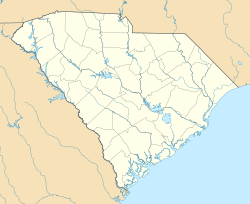Seaside Plantation facts for kids
Quick facts for kids |
|
|
Seaside Plantation
|
|
| Location | 10 miles east of Beaufort on U.S. Route 21, near Beaufort, South Carolina |
|---|---|
| Area | 3 acres (1.2 ha) |
| Built | c. 1795-1810, 1862 |
| Architectural style | Georgian, Federal |
| NRHP reference No. | 79002375 |
| Added to NRHP | July 16, 1979 |
Seaside Plantation is a very old house on Saint Helena Island in South Carolina. It's also known as the Edgar Fripp Plantation. This historic house was built a long time ago, between 1795 and 1810. It's a two-story building with a special mix of old architectural styles called Georgian and Federal.
Seaside Plantation is important because of its history, especially its connection to a time when enslaved people worked on plantations. It was also part of a special project called the Port Royal Experiment. Today, it's one of the few old plantation houses left on Saint Helena Island.
Contents
What is Seaside Plantation?
Seaside Plantation is a large, two-story house made of wood. It has a unique look because it mixes two older building styles:
- Georgian style: This style was popular in the 1700s. It often features balanced and grand designs.
- Federal style: This style came after Georgian and was popular in the early 1800s. It often has more delicate details.
The house has a one-story porch with a sloped roof, which is called a portico. This adds to its classic appearance.
When Was Seaside Plantation Built?
The main house at Seaside Plantation was built sometime between 1795 and 1810. This means it's over 200 years old! Over the years, some parts of the property might have been changed or added, like in 1862.
What Else is on the Property?
Besides the main house, the property still has some other old structures. These include:
- An original brick-lined well: This was used to get water.
- A clapboard shed: A small building for storage.
- A large barn: This barn has wooden siding and a metal roof.
- A round silo: This was used to store food for animals. It's made of concrete and oyster shells.
Seaside Plantation and the Port Royal Experiment
Seaside Plantation played a role in a very important time in American history called the Port Royal Experiment. This experiment happened during the American Civil War.
What Was the Port Royal Experiment?
The Port Royal Experiment was a special project that started in 1861. It happened in the Sea Islands of South Carolina, including Saint Helena Island. When Union soldiers took control of these islands, many plantation owners left. Thousands of enslaved people were left behind.
The experiment was a plan to help these formerly enslaved people. It aimed to:
- Teach them to read and write.
- Help them manage the land they had worked on for so long.
- Show that they could be free and successful.
Who Worked at Seaside During the Experiment?
Two important people were involved with Seaside Plantation during the Port Royal Experiment:
- Charles Pickard Ware (1840–1921): He was a labor superintendent at Seaside. This means he helped organize and manage the work on the plantation during the experiment. He worked with the formerly enslaved people to grow crops.
- Charlotte Forten Grimké (1837-1914): She was an African American writer and educator. She lived at Seaside Plantation during the experiment. She taught children and adults who had been enslaved. She wrote about her experiences in a diary, which gives us a lot of information about this time.
Why is Seaside Plantation Important Today?
Seaside Plantation is important for several reasons:
- Historical significance: It helps us understand what plantation life was like before the Civil War.
- Architectural history: It shows us the building styles of the late 1700s and early 1800s.
- Connection to the Port Royal Experiment: It reminds us of a time when people worked to help formerly enslaved people build new lives.
Along with Tombee Plantation, Seaside is one of the few remaining old plantation houses on Saint Helena Island. It helps us remember and learn about the past.
National Register of Historic Places
Seaside Plantation was recognized as a very important historical site. It was added to the National Register of Historic Places in 1979. This list includes places across the United States that are important to history, architecture, archaeology, engineering, or culture. Being on this list helps protect the site for future generations.



